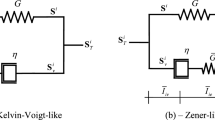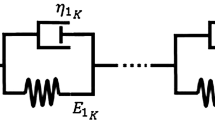Abstract
One of the successful approaches to model the time-dependent behaviour of elastomers is proposed by Bergström and Boyce (JMPS 46:931–954, 1998). The model is micromechanically inspired from the relaxation of a single entangled chain in a polymer gel matrix. Although the theory of inelasticity based on multiplicative decomposition of the deformation gradient is well established, the complexity of the nonlinear evolution law as well as the nonlinear equilibrium and non-equilibrium material response necessitates a precise description of the algorithmic setting. This contribution presents for the first time a novel numerical implementation of the Bergström–Boyce model in the context of finite element analysis and elaborates theoretical aspects of the model. The thermodynamical consistency of the evolution law is proven and a parameter study with respect to the material parameters has been carried out. The agreement of the model with the recent experimental data is investigated.
Similar content being viewed by others
References
Bergström JS, Boyce MC (1998) Constitutive modeling of the large strain time–dependent behavior of elastomers. J Mech Phys Solids 46: 931–954
Reese S, Govindjee S (1998) A theory of finite viscoelasticity and numerical aspects. Int J Solids Struct 35: 3455–3482
Lubliner J (1985) A model of rubber viscoelasticity. Mech Res Commun 12: 93–99
Simo JC, Miehe C (1992) Associative coupled thermoplasticity at finite strains: formulation, numerical analysis and implementation. ASME J Appl Mech 98: 41–104
Simo JC (1992) Algorithms for static and dynamic multiplicative plasticity that preserve the classical return mapping schemes of the infinitesimal theory. Comput Methods Appl Mech Eng 99: 61–112
Weber G, Anand L (1990) Finite deformation constitutive equations and a time integration procedure for isotropic hyperelastic-viscoplastic solids. Comput Methods Appl Mech Eng 79: 173–202
Cuitino A, Ortiz M (1992) A material-independent method for extending stress update algorithms from small-strain plasticity to finite plasticity with multiplicative kinematics. Eng Comput 9: 437–451
Ogden R (1972) Large deformation isotropic elastictiy: on the correlation of theory and experiment for incompressible rubberlike solids. Procee R Soc Lond A 326: 565–584
Areias P, Matous K (2008) Finite element formulation for modeling nonlinear viscoelastic elastomers. Comput Methods Appl Mech Eng 197: 4702–4717
Marckmann G, Verron E (2006) Comparion of hyperelastic models for rubber-like materials. Rubber Chem Technol 12: 835–858
Treloar LRG (1944) Stress–strain data for vulcanised rubber under various types of deformation. Trans Faraday Soc 40: 59–70
Kawabata S, Matsuda M, Tei K, Kawai H (1998) Experimental survey of the strain energy density function of isoprene rubber vulcanizate. Macromolecules 14: 154–162
Kaliske M, Heinrich G (1998) An extended tube–model for rubber elasticity: statistical–mechanical theory and finite element implementation. Rubber Chem Technol 72: 602–632
Miehe C, Göktepe S, Lulei F (2004) A micro–macro approach to rubber–like materials. Part I: The non–affine micro–sphere model of rubber elasticity. J Mech Phys Solids 52: 2617–2660
Arruda EM, Boyce MC (1993) A three–dimensional constitutive model for the large stretch behavior of rubber elastic materials. J Mech Phys Solids 41: 389–412
Green MS, Tobolsky AV (1946) A new approach to the theory of relaxing polymeric media. J Chem Phys 14: 80–92
Lodge AS (1956) A netowork theory of flow birefringence and stress in concentrated polymer solutions. Trans Faraday Soc 52: 120–130
Phan-Thien N (1978) A nonlinear network viscoelastic model. J Rheol 22: 259–283
Tanaka F, Edwards SF (1992) Viscoelastic properties of physically crosslinked networks. I: Non–linear stationary viscoelasticity. J Non-Newtonian Fluid Mech 43: 247–271
Tanaka F, Edwards SF (1992) Viscoelastic properties of physically crosslinked networks. II: Dynamic mechanical moduli. J Non-Newtonian Fluid Mech 43: 289–309
de Gennes PG (1971) Reptation of a polymer chain in the presence of fixed obstacles. J Chem Phys 55: 572–579
Doi M, Edwards SF (1986) The theory of polymer dynamics. Clarendon Press, Oxford
Miehe C, Göktepe S (2005) A micro–macro approach to rubber–like materials. Part II: The micro–sphere model of finite rubber viscoelasticity. J Mech Phys Solids 53: 2231–2258
Miehe C (1998) A constitutive frame of elastoplasticity at large strains based on the notion of a plastic metric. Int J Solids Struct 35: 3859–3897
Amin AFMS, Lion A, Sekita S, Okui Y (2006) Nonlinear dependence of viscosity in modeling the rate-dependent response of natural and high damping rubbers in compression and shear: Experimental identification and numerical verification. Int J Plast 22: 1610–1657
Cohen A (1991) A Padé approximant to the inverse langevin function. Rheol Acta 30: 270–273
Diani J, Gilormini P (2005) Combining the logarithmic strain and the full-network model for a better understanding of the hyperelastic behaviour of rubber-like materials. J Mech Phys Solids 53: 2579–2596
Simo JC, Taylor RL, Pister KS (1985) Variational and projection methods for the volume constraint in finite deformation elasto–plasticity. Comput Methods Appl Mech Eng 51: 177–208
Miehe C (1994) Aspects of the formulation and finite element implementation of large strain isotropic elasticity. Int J Numer Methods Eng 37: 1981–2004
Bergström JS, Boyce MC (2001) Constitutive modeling of the time-dependent and cyclic loading of elastomers and application to soft biological tissues. Mech Mater 33: 523–530
Huber N, Tsakmakis C (2000) Finite deformation viscoelasticity laws. Mech Mater 32: 1–18
Author information
Authors and Affiliations
Corresponding author
Rights and permissions
About this article
Cite this article
Dal, H., Kaliske, M. Bergström–Boyce model for nonlinear finite rubber viscoelasticity: theoretical aspects and algorithmic treatment for the FE method. Comput Mech 44, 809–823 (2009). https://doi.org/10.1007/s00466-009-0407-2
Received:
Accepted:
Published:
Issue Date:
DOI: https://doi.org/10.1007/s00466-009-0407-2




